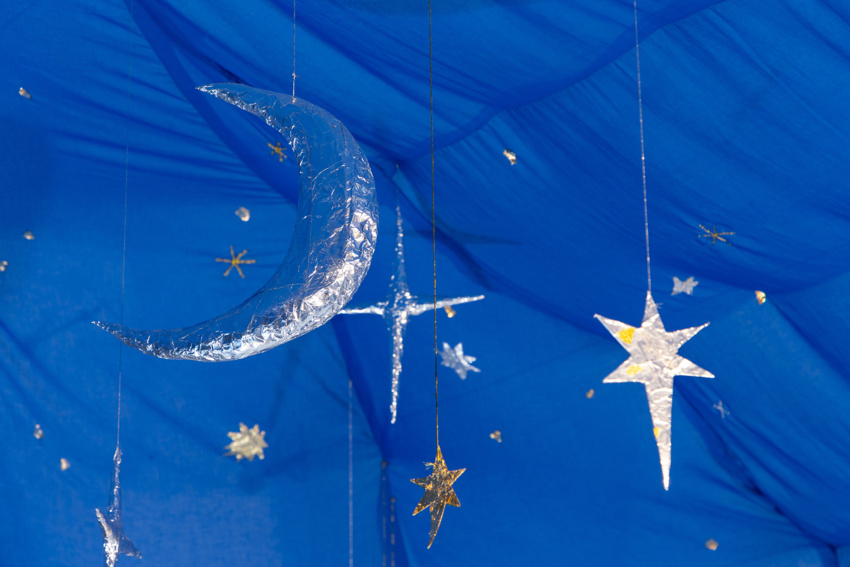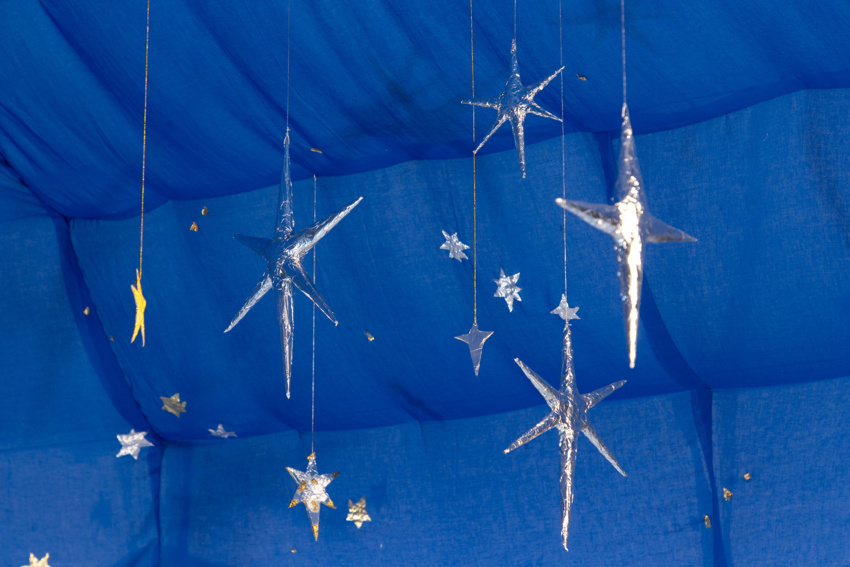Tamara MacArthur: Wished On the Moon For More than I Ever Knew

Wished On The Moon For More Than I Ever Knew
or
What if fantasy was just longing all along?
[Fiction] is a way of trying to describe what is in fact going on, what people actually
do and feel, how people relate to everything else in this vast stack, this belly of the universe, this womb of things to be and tomb of things that were, this unending story. … Still there are seeds to be gathered, and room in the bag of stars.
Ursula K. Le Guin, Carrier Bag Theory of Fiction

It was a good day, after running errands and spending an hour at the park, reading in the sun. I started my walk to Kunsthalle Lissabon, as the weather allowed so, and at 6:02 pm I arrived, being greeted as the first person to the opening. I had been following the social networks of the institution, and of my friends that run it, and I knew this would be something big — as I knew it would also be something I would rather enjoy alone. There would be a performance, I had been told, and only on this day of the opening. I was happy to be first, to be alone — for sometimes alone, unprotected by the proximity of someone you love or enjoy company, is the best way to be vulnerable to a fantastical unknown.
Walking into Tamara MacArthur’s installation Wished On The Moon For More Than I Ever Knew was like walking into a dream. A carefully-built environment unveiled in front of me, as panelled mountains gave way to a small bridge over a seemingly invisible river—there I was, under the sign of countless stars, the sound of the theremin and of space itself. At the end of this magical path, a small lake was home to a fallen star, with a human face that stared at me and smiled. The mountains had transformed into small cliffs, where I sat, alone with the star. Their eyes and mouth smiled at me for the whole time—it was just the two of us—and I looked around at the installation to avoid their stare: there was my body, surrounded by paper mountains and sprinkled stars on a thin dome of deep blue. A shy moon hung from above the fallen star, as a remembrance of the sky and home. Does the star wish on the moon? Could I? Maybe I would have wished for this to last a bit longer, as I heard voices coming down the stairs and realised it was time to leave. I thanked the star, as I thanked Tamara, for this moment.

Tamara MacArthur’s work, especially Wishing on the Moon, is something that transports me to another dimension: to a world of dreams that my little self would only find in fantasy books. Their play with scenographic construction allows us to plunge into the worlds they create, which makes our bodily relationship with the artwork [and the moment of inhabiting it] so very powerful. But their world-building is not only material: it is as if all these sensibilities, smiles, and tears were the glue that kept everything together, everything alive. At KL, MacArthur built a world of mountains, paper, stars, and glitter, but also of melancholy, of longing, of dreaming: the feeling of smallness when gazing at a dark starry sky, the bodily motion in our chest when looking up at a luminous moon — all these sensations and feelings swirling in such a small place. I believe art is rather about affects, about the pains and joys of being alive, of being a body in a world. And in MacArthur’s artworks, I find places to be sensible, to be vulnerable: I find art which is emotion — or maybe, even, emotion that is art.
As I left KL, I had the feeling that I had left something there, but also that I had brought so much more with me. As the days went by, I found myself daydreaming about the installation, carrying it with me for a bit longer as I thought about the singularities and sensibilities of that magical place. While referring to children’s stories, pop songs, and our relationship to the natural world, MacArthur’s [true] fantasy is intimacy, closeness, and understanding. By building worlds, they truly materialise landscapes and dreamlands where, through performance, they can realise this fantasy. In these worlds, MacArthur waits to give us everything, careful and tactfully reaching out to us while inviting us to give back as much as we want. Their performances, stretching for hours, are charged with emotion and intensity; there, it becomes impossible not to feel.
With fantasy at the heart of their work, MacArthur crafts sites to explore their vulnerability, yearning for shared sensibilities to interact with their own in an ever-growing, ever-changing ecosystem of sentiment and consciousness. They know you cannot ask for vulnerability without showing it first, and that is why MacArthur wallows in their feelings, building these spaces around themselves out of their own emotions, preparing for the day when it all comes about. Collecting energies, exchanges, affects, they bring it all out to the surface when performing — when the true moment of vulnerability takes place. And its intensity could be almost cathartic [as if a flood came about], if vulnerability were not the place of reciprocity itself: MacArthur lays there, in the deepness of their own feelings, releasing but simultaneously absorbing ours, like a glittery-eyed sponge.
In this cycle, our own bodies feed the performative act, making us a fundamental part of it, while allowing us to maintain our identity—even, I dare say, inviting us to share our true identity. This is the true meaning of care: allowing yourself and others to feel vulnerable, while mutually agreeing on boundaries.
These dreamscapes live on after the performance; yet, as they are built out of the unstable matter that makes up feelings, they are [the closest to] a real reflection of an inside-world — as such, their lives are constrained to the space and time where they exist. Their purpose is to be there, in their now; to be built by the hands that create and the ones that help; to be conjoined by layers of sensibility and togetherness. At the end of the exhibition, all this will be torn down, layer by layer, and cease to exist, like a frugal, sparkling emotion that takes us by surprise only to disappear in a matter of seconds. And just like a feeling, like a falling star, it does not matter how much we want to hold on to it: it is already gone — faded, changed, every experience is always different, as are we.
Sometimes, art is wishing.

Marta Espiridião, Independent curator and researcher, is currently a Ph.D. student in Transart Institute with the research project "Feminist Killjoys: New Embodiments in Moving Image”, in which is established a direct relationship between the democratization of the arts and accessibility to art-making devices and the global advent of film in the XX century, which made these technologies accessible to women, queer, and racialized bodies, at the same time that questions of gender, sexuality and race hegemony started to be rendered visible.
In the last years curated many exhibitions and programs, like the collective exhibition and public program "Error 417: Expectation Failed" (2021-2), winning project of the curatorial competition “Expo’98 no Porto”, Oporto Municipal Gallery; "Sonic Materialities" (2020), an engagement program and exhibition of Andreia Santana, funding awarded by Criatório; and created several independent curatorial projects, of which is highlighted "Bodies in Space - critical archive of non-normative experiences of the city" (Lisbon), a critical space to re-think the place of non-normative bodies within urban landscapes, how they relate to common surroundings, and in what ways the city exerts discriminatory violence over identities and bodies.
Tamara MacArthur, Wished On the Moon For More than I Knew. Exhibition views. Photography: Bruno Lopes. Courtesy of the Artist and Kunsthalle Lissabon.










